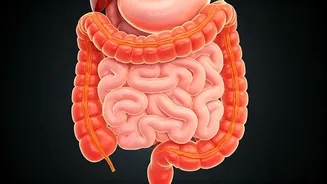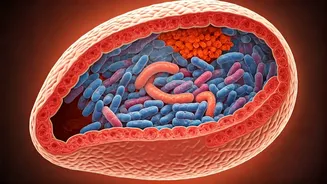Hidden Gut Threats
The path to optimal health is often paved with good intentions, especially when it comes to diet. However, some foods widely considered healthy can surprisingly
undermine your gut's well-being. A Harvard doctor's findings point to six such foods that are detrimental to the gut. This information is particularly relevant for those seeking to enhance their digestive health, as the gut plays a critical role in overall wellness. It's crucial to understand that food affects everyone differently. The foods mentioned in this article are not universally harmful but can be significant factors for individuals already facing gut-related issues. Understanding this can help you better tailor your dietary choices to support your personal health goals.
Offending Food #1
This section typically discusses the first food identified as detrimental to gut health, according to the Harvard doctor. The article would likely delve into the specific characteristics of this food that make it challenging for the digestive system. For instance, the discussion might focus on how this food is processed or its composition, and how it can trigger inflammation or disrupt the balance of gut bacteria. Additionally, the article could explain how this food contributes to specific symptoms, such as bloating, gas, or changes in bowel movements. It is important to emphasize that while this food may be part of a healthy diet for many, individuals with gut sensitivities or pre-existing digestive conditions may need to moderate their intake or find alternative options to mitigate its adverse effects on their gut health. The goal of this discussion is to provide a detailed overview of the first gut-harming food and its impact on the digestive system, based on the Harvard doctor's insights.
Food #2 Unveiled
Building on the previous section, this part of the article would analyze the second food item identified as being harmful to gut health. The narrative would focus on its properties and the way it interacts with the digestive system. It's important to highlight potential risks associated with consuming this food, like the production of certain compounds or its effect on the gut lining. To make the information more digestible and relatable, the article could include examples or case studies demonstrating how this food affects various individuals. This segment also explains potential strategies or changes one might need to make in their diet. It would offer suggestions on how people with digestive sensitivities could approach the food in their diet to potentially alleviate associated discomfort. The emphasis here is on helping readers understand the specific ways this food may upset their gut's equilibrium, and how to improve their dietary habits.
Food Item 3 Revealed
Now moving to the third food item presented, this section should provide a focused analysis of why this particular food can be disruptive to the gut's health, according to the Harvard doctor. The discussion would center on its composition, the processing it undergoes, or other characteristics that might be problematic. It would explain the different ways it can cause problems for people's digestive systems, going into details about how it may affect gut flora, how the food is absorbed, or how it contributes to inflammation. The article may provide context through concrete examples and explain the mechanisms through which this food might lead to symptoms like stomach pain, bloating, or irregular bowel movements. A key aim of this section is to give readers a thorough understanding of the specific health effects of the third food and suggest any modifications to dietary routines to improve gut function.
The Fourth Culprit
This section explores the fourth food that the Harvard doctor identifies as potentially damaging to gut health. The discussion should analyze its components, how it’s processed, or other unique properties which can adversely affect the digestive system. The article will highlight specific examples of how the food might influence the gut. It will explain how this food may impact the balance of the gut flora, interfere with nutrient absorption, or trigger inflammation. The piece may also discuss possible consequences such as digestive distress, like gas, bloating, or irregularities in bowel habits, and highlight the reasons this food should be treated with caution by those with sensitive digestive systems. The primary goal is to provide a thorough review of the fourth food item in the context of gut health and present information that readers can use to modify their dietary habits.
Food #5's Impact
This part of the article centers on the fifth food item identified as being potentially detrimental to gut health, according to the Harvard doctor. The discussion will analyze the food's properties and its effect on the digestive process. A focus would be placed on how the food may negatively impact the gut's balance and the possible outcomes of its consumption. The article should explain the mechanisms through which the food may influence the gut's microbiome or contribute to inflammation. Examples of how this food contributes to digestive issues, such as bloating, discomfort, or irregular bowel movements will also be discussed. The aim of this section is to furnish readers with a clear understanding of the fifth food and its potential influence on gut well-being, along with advice on adapting one's dietary choices for improved gut health.
Final Food Unmasked
Concluding the list, this section focuses on the sixth food that the Harvard doctor singles out for potential harm to gut health. The article will analyze the characteristics of this food and how these characteristics might negatively affect the digestive system. The discussion should include specific instances of how this food can impact the gut, explaining how it affects the microbiome or contributes to inflammation. Potential outcomes linked to the consumption of this food, such as bloating, discomfort, or changes in bowel regularity, will be examined. It should also furnish readers with guidance on how to adjust their diet in ways that could help improve their gut function and promote general health. The core of this section is to provide a complete overview of the sixth food and its relationship to digestive health based on the doctor's findings.
Alternatives & Options
Once the six potentially harmful foods have been discussed, this section shifts to provide positive solutions. It explores alternative foods that can be incorporated into your diet to improve gut health and promote overall well-being. It might recommend fiber-rich foods, probiotics, prebiotics, and foods that are easier to digest. The goal is to present practical choices for readers who want to adjust their diets and mitigate the possible negative effects of the foods discussed earlier. The information is designed to empower individuals with the knowledge and tools they need to improve their gut health through dietary changes, suggesting substitutions and providing a pathway for those seeking to make more health-conscious food choices. The section intends to shift from warning against certain foods to providing positive options for a healthier lifestyle.
Dietary Adjustments
Beyond simply suggesting alternative foods, this section delves into practical advice for making dietary adjustments. It may provide guidance on portion control, the combination of foods, and mindful eating. The article will provide strategies on how to approach eating out, grocery shopping, and meal preparation with the goal of improving gut health. To make the advice actionable, examples or sample meal plans that integrate the recommendations might be included. By providing practical steps, this section helps readers translate knowledge into everyday habits, giving them the tools they need to transform their diets. The objective is to equip individuals with the skills and confidence to embrace dietary changes, promoting a positive and sustainable approach to gut health management.
Consult a Pro
The concluding section emphasizes the significance of consulting healthcare professionals for individualized guidance. The article should recommend seeking advice from a gastroenterologist or a registered dietitian who can assess individual needs and develop a customized eating plan. It reinforces that while information in the article provides general guidelines, each person's gut health requirements can vary significantly. The article stresses the benefits of professional consultation, like specific dietary advice, and personalized strategies for improved gut health. The aim is to motivate readers to consider consulting professionals for personalized advice, which supports their overall health and well-being. This final piece of the article should highlight the significance of expert support for long-term health management.











